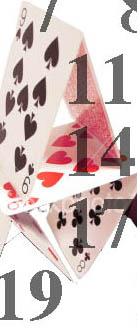
My son, Oliver (age 6), invented a card game (using traditional poker cards) that he calls “Civil War” (CW). From an outsider’s perspective, it looks like “ Battle,” a straightforward game where you divide a deck of cards between players and each player throws down one card at a time, with the higher card capturing/defeating the lower card. But CW most strongly resembles Yu-gi-oh, a Japanese trading card game in which different cards have different functions (Spell Cards, Monster Cards, etc). Yu-gi-oh is much more complex than Battle because it is not always easy to understand how much power a card possesses; a card’s power depends on several contingencies—other cards on the field, the special properties of a particular card, etc.. CW is also, at first glance, a classical “turn-taking” game with the definite goal of winning by a process of (as with Yu-gi-oh) draining the opposing player of “life points”, but the game also contains elements of improvisational play, largely enacted and directed (“scored”) by Oliver that undermine the conventional aspects of a turn-taking, zero-sum game and focus attention more on the unpredictable back-n-forth between players.
CW is a good example of M-BOD, but before I get into the particulars of my argument, I need to provide some context for the game’s invention. To understand why Oliver made up this game, you have to understand that he cannot read very well yet, so playing Yu-gi-oh with his brother is something he can only do in a pretend way. Oliver spends a good deal of his time playing (or wanting to play) with his brother; this means also a good deal of time spent watching his brother and his (11-year old) friends playing their favorite game, Yu-gi-oh. Oliver collects his own cards and, over time, has learned the names and some of the details pertaining to each monster and several other kinds of cards. On rare occasion, when there’s no one else around, and boredom or domestic chores loom large, the big brother will agree to (sorta) play Yu-gi-oh with Oliver. But that game exchange between older and young sibling is not satisfying to either because of the different levels of print literacy they possess. So, Oliver created CW, I believe, as what Gee would call a “precursor” game to Yu-gi-oh (68). What I notice when I play CW at different times with Oliver is that he has found ways to challenge himself—to play a game as complex and nuanced as Yu-gi-oh—without being able to read. The substitution of regular poker cards for the intricately layered Yu-gi-oh cards allows Oliver to be a viable player since he can count and add/subtract. But the game is just as complicated as Yu-gi-oh, and that’s what my documentary tries to capture: the complexity of CW.
In the analysis that follows, I will comment on different moments in the video text that I created about Oliver’s game. I made the video at a summer institute for teachers of multi-media composition at Ohio State University (Digital Media and Composition, or DMAC). I will assume that my readers will have watched the documentary (6 minutes).
One: Situating Embodied Learning
-
Identity and Learning: “Follow What I Am Doing: Do The Rules That I’m Doing: It’s Very CoM-pli-cated”
- Producelike Behavior: "Why Do The Make Queen Better Than Jack?"
- Conclusion: "The Bricolage, The Music, The Movement"
Three: Implications for the Literacy Autobiography Assignment
